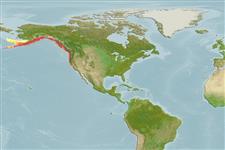>
Gadiformes (Cods) >
Gadidae (Cods and haddocks)
Etymology: Microgadus: Greek, mikros = samll + Latin, gadus = a fish, cod? (Ref. 45335); proximus: From the Latin 'proximus' meaning next (Ref. 6885).
More on author: Girard.
Environment: milieu / climate zone / depth range / distribution range
Écologie
marin; saumâtre démersal; océanodrome (Ref. 51243); profondeur 0 - 275 m (Ref. 1371), usually 25 - 120 m (Ref. 1371). Temperate; 62°N - 36°N, 179°W - 121°W (Ref. 1371)
Eastern Pacific: southeastern Bering Sea to central California, USA.
Taille / Poids / Âge
Maturity: Lm ? range ? - ? cm
Max length : 30.5 cm SL mâle / non sexé; (Ref. 27436)
Épines dorsales (Total) : 0; Rayons mous dorsaux (Total) : 46 - 54; Épines anales: 0; Rayons mous anaux: 38 - 46. Body olive green dorsally, pale ventrally; fins dusky marginally.
Generally found over sand (Ref. 1371). May enter brackish water (Ref. 1371). Young move into shallow waters in summer and fall, whereas adults usually stay in deeper waters (Ref. 28499). Feeds on shrimps, amphipods, isopods, gastropods, mussels and fishes (Ref. 1371). An important prey species (Ref. 2850).
Oviparous, sexes are separate (Ref. 205).
Cohen, D.M., T. Inada, T. Iwamoto and N. Scialabba, 1990. FAO species catalogue. Vol. 10. Gadiform fishes of the world (Order Gadiformes). An annotated and illustrated catalogue of cods, hakes, grenadiers and other gadiform fishes known to date. FAO Fish. Synop. 125(10). Rome: FAO. 442 p. (Ref. 1371)
Statut dans la liste rouge de l'IUCN (Ref. 130435)
Menace pour l'homme
Harmless
Utilisations par l'homme
Pêcheries: intérêt commercial mineur; pêche sportive: oui
Outils
Articles particuliers
Télécharger en XML
Sources Internet
Estimates based on models
Preferred temperature (Ref.
123201): 3.4 - 9.5, mean 5.8 °C (based on 253 cells).
Phylogenetic diversity index (Ref.
82804): PD
50 = 0.7500 [Uniqueness, from 0.5 = low to 2.0 = high].
Bayesian length-weight: a=0.00794 (0.00418 - 0.01508), b=3.10 (2.94 - 3.26), in cm total length, based on LWR estimates for this (Sub)family-body shape (Ref.
93245).
Niveau trophique (Ref.
69278): 3.6 ±0.59 se; based on food items.
Résilience (Ref.
120179): Milieu, temps minimum de doublement de population : 1,4 à 4,4 années (tm=2).
Fishing Vulnerability (Ref.
59153): Low to moderate vulnerability (27 of 100).
Climate Vulnerability (Ref.
125649): Moderate to high vulnerability (51 of 100).
Nutrients (Ref.
124155): Calcium = 46.3 [26.3, 97.9] mg/100g; Iron = 0.399 [0.223, 0.672] mg/100g; Protein = 18 [17, 19] %; Omega3 = 0.763 [0.383, 1.545] g/100g; Selenium = 13.2 [6.8, 30.3] μg/100g; VitaminA = 14.2 [4.1, 50.1] μg/100g; Zinc = 0.682 [0.480, 0.994] mg/100g (wet weight);
